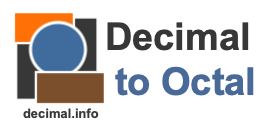
Here we will show you step-by-step how convert the decimal number 9 to octal.
First note that decimal numbers use 10 digits (0, 1, 2, 3, 4, 5, 6, 7, 8, and 9) and octal numbers use only 8 digits (0, 1, 2, 3, 4, 5, 6, and 7).
As we explain the steps to converting 9 to octal, it is important to know the name of the parts of a division problem. In a problem like A divided by B equals C, A is the dividend, B is the divisor and C is the Quotient.
The Quotient has two parts. The Whole part and the Fractional part. The Fractional part is also known as the Remainder.
To convert the decimal number 9 to octal, you follow these steps:
Step 1) Divide 9 by 8 to get the Quotient. Keep the Whole part for the next step and set the Remainder aside.
Step 2) Divide the Whole part of the Quotient from step 1 by 8. Again keep the Whole part and set the Remainder aside.
Step 3) Repeat Step 2 above until the Whole part is 0.
Step 4) Write down the Remainders in reverse order to get the answer to 9 as an octal.
Here we will show our work so you can follow along:
9 ÷ 8 = 1 with 1 remainder
1 ÷ 8 = 0 with 1 remainder
Then, when we put the remainders together in reverse order, we get the answer. The decimal number 9 converted to octal is therefore:
11
So what we did on the page was to Convert A10 to B8, where A is the decimal number 9 and B is the octal number 11. Which means that you can display decimal number 9 to octal in mathematical terms as follows:
910 = 118
Decimal to Octal Converter
Need another decimal number as an octal number? How to convert 9 to octal is not all we know. Convert another decimal to octal below:
How to convert 10 to octal
Here is our next decimal to octal tutorial on our list.
Copyright | Privacy Policy | Disclaimer | Contact
